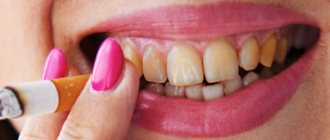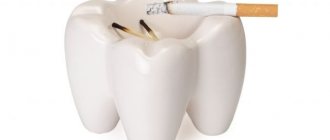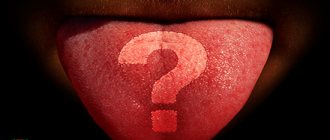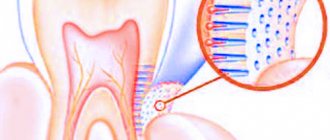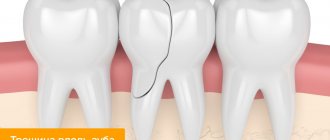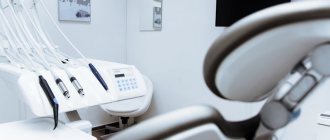A snow-white smile, which is also often called “Hollywood,” is quite often the dream of many people and an excellent decoration for a person’s appearance and presentability. In order for it to be truly awarded such a high-profile name, it must meet many criteria, including a correct bite, an even dentition, white and clean enamel, and the absence of plaque on the teeth. But not everything always corresponds to the norms; in this article we will try to find out what to do if tooth enamel begins to darken.
The main objective of the article is to expand knowledge about teeth and tooth enamel, the causes and consequences of its darkening, as well as ways to prevent this process.
Black plaque: causes, removal.
Most often, dental plaque is of bacterial origin and is associated with insufficient oral hygiene. However, some people, even with good hygiene, may develop a black coating. In adults, it is most often associated with the deposition of pigments (phenolic compounds) found in nicotine, tea and coffee.
Against the background of good hygiene, black plaque on a child’s teeth can occur due to the activity of chromogenic bacteria that produce certain pigments, as well as the use of certain mouth rinses, the use of chewable forms of vitamin preparations...
Classification of dental plaque.
Thus, plaque on teeth can be divided into that which is associated with external bacterial contamination of the tooth, and that which is associated with the deposition of pigments on the surface of the tooth.
Insufficient oral hygiene causes:
- soft microbial plaque,
- partially mineralized plaque,
- hard tartar.
Black plaque occurs against the background of good oral hygiene:
- medicines and foods rich in iron,
- in children – as a consequence of the activity of chromogenic bacteria,
- use of certain antiseptics and mouth rinses.
Darkening and staining of enamel
These two concepts are interrelated. Most often, dental patients in their assumptions confuse the process of darkening the tooth itself and staining the tooth enamel. Although many lovers of coffee, wine and cigarettes are well aware of how these things affect discoloration, such plaque is quite easy to get rid of using regular toothbrush.
Nowadays, there are many fairly affordable ways to whiten teeth. A specialist who professionally masters this skill will qualitatively remove all coloring substances that remain on the enamel after drinking wine, cigarettes and coffee.
As for its structure and properties, it itself is translucent and has a slightly noticeable white tint. The color of teeth that we directly observe and perceive as the color of enamel is most often the color of dentin, which is located under the enamel of the tooth. Sometimes, even professional whitening or good and diligent care does not help to see a snow-white smile, because the enamel will be fine, but since it is translucent, darkening of the dentin is observed (this occurs due to age-related or painful changes, or from genetic heredity).
And if the problem is observed even despite all external methods, then the reasons must be sought within the body.
Bacterial plaque.
Bacterial plaque on teeth is also called soft microbial plaque. It consists of colonies of microorganisms (bacteria), and has a soft, loose consistency, due to which it is easily removed from the teeth with a regular toothbrush. It accumulates mainly in the neck area of the teeth.
If bacterial plaque has a hard consistency and is not removed from the teeth during brushing and paste, then it is more correct to call it tartar. The latter occurs when soft microbial plaque is mineralized by calcium and phosphorus salts contained in saliva. Mineralization causes the plaque to harden and can no longer be removed with a regular toothbrush.
Bacterial plaque: causes of formation.
The oral cavity contains a lot of bacteria, and they constantly multiply. Even on well-cleaned teeth, after just 6 hours, a mass of bacterial plaque is clearly visible to the eye. But the maximum increase in the number of bacteria occurs immediately after eating, which is due to the presence of food residues that bacteria begin to process.
And for this, bacteria do not need large pieces of food between the teeth - they only need the invisible film of carbohydrates and proteins that remains on the teeth after eating, not to mention the fragments of food remaining in the interdental spaces. That is why it is so important to brush your teeth in the first 10 minutes after eating, including mandatory cleaning of the interdental spaces with dental floss.
Otherwise, the mass of bacterial plaque will increase tenfold within a few hours. And you can easily notice white plaque on the teeth, accumulating mainly in the neck area. Plaque forms especially quickly in people who, in between main meals, like to snack on candy or a bun, or sweet drinks, without brushing their teeth afterwards.
Important: as we have already said, after the formation of bacterial plaque, the process of its gradual mineralization immediately begins, as a result of which the soft plaque begins to turn into hard tartar. The time of primary mineralization, when the soft plaque seems to “set”, occurs within approximately 10–16 hours. As a result, the plaque hardens (although after this time it still remains a little loose) and it is almost impossible to remove it with a regular manual toothbrush.
When plaque has already firmly adhered to the surface of the teeth, this facilitates the adhesion of new portions of plaque to the teeth, which leads to the rapid formation of layers of dental plaque. Thus, there is only one cause of dental plaque – insufficient oral hygiene. But there are also predisposing factors, for example: mouth breathing, low levels of lysozyme in saliva.
Possible complications
Of course, with brown layers there is no need to talk about aesthetics. This is an important aspect, but not the main one. Deposits must be removed before they cause serious oral ailments. When the enamel turns black, an irreversible problem develops, such as gingival bleeding caused by plaque around the gums, or tartar, periodontitis or gingivitis, complete destruction of the enamel and increased sensitivity of the units. When the first signs of darkening appear, you should immediately consult a doctor. Do not ignore the disease, as it may indicate diseases of the internal organs.
In such a situation, the patient is referred for consultation to a gastroenterologist, endocrinologist or infectious disease specialist. After receiving information from specialists, the dentist develops a program to restore the color of the affected units and remove plaque between the teeth. If tuberculosis or diabetes mellitus, allergies or parasite infection, gallbladder dyskinesia or other serious ailments are diagnosed, the dentist begins work after treating them.
Pigmented dental plaque in adults and children.
In adults, pigmented plaque on teeth is most often formed due to polyphenolic compounds found in nicotine, tea and coffee, and some foods. With satisfactory oral hygiene, such people will not have bacterial plaque and tartar on their teeth. If hygiene is poor, then in addition to pigmentation on the teeth, you can see both stone and soft microbial plaque. Pigmented black plaque on teeth forms especially quickly in those adults who brush their teeth irregularly. This is due to the fact that pigments adhere much more easily to tooth enamel, the surface of which is already covered with a layer of bacterial plaque or tartar. It is much more difficult for pigments to adhere to clean, smooth enamel.
Black plaque on teeth in children: causes
There are always bacteria in the mouth called actinomycetes. They are anaerobic bacteria and are often called chromogenic bacteria. It is these bacteria that are responsible for the appearance of black or brown spots in children, most often localized circularly in the area of the necks of the teeth.
Such black spots are formed as a result of the interaction of hydrogen sulfite produced by actinomycetes - with iron contained in saliva, or (in the presence of bleeding gums) - with iron contained in red blood cells. As a result, an insoluble form of iron with impurities of calcium and phosphorus is deposited on the teeth.
This staining of teeth is called “chromogenic.” Keep in mind that the chromogenic staining mechanism can result in plaque that is not only dark (black) in color. The latter can have an orange, brown and even green tint.
Other reasons for the formation of dark plaque in children and adults
- Antiseptics and mouth rinses - dark plaque on a child’s teeth can also appear as a result of using the antiseptic Chlorhexidine for mouth rinsing, which is sold both in pure form and can be included in some mouth rinses. It can also cause the appearance of dark plaque and the antiseptic benzalkonium chloride, a quaternary ammonium compound. It is included both in the Kamistad anesthetic gel, which is often used in children, and in some mouth rinses. Research has also found that dark staining of teeth can occur after prolonged use of rinses with essential oils (phenols), for example, Listerine "
- Metal salts – eating iron-rich foods, taking chewable forms of vitamins, as well as medications containing iron salts.
When black caries still needs to be filled?
You need to clean a black spot using a drill if:
- the patient complains of increased sensitivity to sour, salty and sweet foods, temperature changes;
- when there is mechanical impact on the damaged crown, pain occurs;
- the hole is growing in size too quickly;
- the speck is located in the area of the neck of the tooth;
- there was an unpleasant odor from the mouth;
- The black defect is localized on the incisors and spoils the smile.
In all these cases, the fight against carious lesions is carried out according to the classical scheme. The patient is injected with an anesthetic, after which the carious lesion is cleaned from altered tissues using a drill. The cleaned area is treated with an antiseptic and filled with a filling solution. The latter is dried with a lamp and then sanded to achieve the correct shape and perfect smoothness. As a result, the unit begins to look aesthetically pleasing, and its service life increases significantly.
Removing dental plaque: methods
If you only have dark plaque on your teeth, or in extreme cases, in addition to pigmented plaque, there is also a small amount of small hard dental plaque (and only supragingival), then in this case you can get rid of plaque well at home. Another condition is that the layer of such plaque should not be too thick.
However, if you have massive supragingival hard dental deposits (or there are subgingival deposits, even in small quantities) or a very pronounced layer of pigmented plaque, then getting rid of plaque can only be done by a dentist.
Treatment or tooth root extraction
If the root of a tooth is more than 50% caries-covered, it is usually removed. Further treatment is aimed at eliminating the inflammatory process and preventing infection of neighboring tissues. In some cases, it is possible to save a tooth by restoring the root with an artificial onlay.
Dental root caries spreads through hard tissues quite quickly. Gradually, the process of destruction covers the gums and spreads to neighboring teeth. There is a risk of damage to the jaw bone. For this reason, doctors recommend coming for an examination every six months in order to detect pathology in time. At the initial stage it is treated with medication, at the next stage - surgically.
How to remove plaque from teeth at home.
You can remove plaque from teeth at home, firstly, using special toothpastes (they are called whitening). Such pastes can remove not only pigmented plaque from the surface of teeth, but also partially mineralized plaque, and even small tartar.
But only high-quality whitening pastes will do this well. In the composition of such pastes you can find both abrasive substances and agents that loosen dense plaque:
- Abrasive substances - the degree of abrasiveness of toothpastes can be judged by the abbreviation RDA. Pastes for removing plaque must have an RDA of 100 units or higher. The higher the abrasiveness, the higher the effectiveness in removing plaque. Naturally, such pastes cannot be used constantly. You should not buy pastes of this type where the manufacturer does not write the RDA index.
- Substances that loosen plaque - these include primarily pyrophosphates, which have the property of dissolving the tartar matrix, as well as enzymes such as bromelain and papain, as well as polydone. These substances make plaque looser, making it easier to remove with the abrasive component of toothpastes.
PRESIDENT White Plus toothpaste:
- PRESIDENT White Plus toothpaste
- abrasiveness – RDA 200 ,
- contains: abrasive and polishing substances (silicon dioxide and diatomite), as well as calcium glycerophosphate,
- applied only once a week,
- price: from 230 rub. for 30 ml,
- removes severe plaque and even small stones.
Toothpaste LACALUT White:
- abrasiveness – RDA 120,
- contains: abrasive and polishing agents (hydrated silicon dioxide, titanium dioxide), pyrophosphates , sodium fluoride (1357 ppm),
- price: from 240 rubles for 50 ml, from 300 rubles for 75 ml.
Using special toothbrushes.
Removing pigmented and mineralized plaque will be even more effective if you use the following types of brushes to brush your teeth rather than a regular manual toothbrush...
- Ultrasonic toothbrushes - brushes of this type have a built-in generator that produces oscillatory waves in the ultrasonic range (about 1.6 MHz). These waves effectively destroy the attachment of plaque to tooth enamel, and will relieve you of pigmented plaque and even small supragingival tartar.
- Electric toothbrushes - brushes of this type have a working head with bristles, which performs rotational reciprocating movements (about 8 thousand revolutions per minute), as well as about 20 thousand pulsating movements per minute. Such pulsations break up the dense attachment of pigmented or partially mineralized bacterial plaque to the surfaces of the teeth, and rotational movements then help to remove it.
Surgical treatment of tooth root caries
Treatment is often complicated by gum disease. Inflammation of soft tissues is an obstacle to the filling procedure or tooth root removal. In such cases, plastic surgery or gum excision is required. Only after this a temporary filling is installed. When the tissue is completely restored, the doctor performs a permanent filling.
During the treatment of dental roots, a rubber dam is used - a latex plate that allows you to isolate one or more teeth from the area that is affected by the carious process.
In general, the procedure is carried out according to the standard algorithm:
- Application of anesthesia. It is impossible to do without an anesthetic drug during such an operation, because the root and basal areas are most sensitive to external influences.
- Cleaning the carious cavity from necrotic tissue. The doctor uses a drill to excise damaged areas of the tooth to prepare the cavity for filling.
- Treating the tooth with an antiseptic solution. If you apply a filling without disinfection, caries will begin to develop underneath it.
- Filling. Compomer materials that are placed on the root of the tooth are most resistant to the effects of saliva. In addition, they are the most wear-resistant and durable. They contain fluorides, which restore root cement and promote rapid tissue healing.
Tooth root caries develops more often in older people, who, as a rule, have crowns, dentures and other structures in the oral cavity. If they were installed incorrectly or worn out, they must be replaced with new ones. They must exactly match the bite, otherwise the likelihood of recurrent caries increases significantly.
How to remove plaque at the dentist:
Removing plaque from teeth at the dentist is called professional oral hygiene. You can't avoid it if you have:
- significant supragingival dental deposits,
- a pronounced layer of pigment plaque,
- there is subgingival dental plaque (even in the smallest amount).
Cleaning plaque with Air Flow:
The AirFlow method is something like sandblasting. From a special tip under high pressure, a water-air mixture with particles of an abrasive-polishing substance is supplied to the tooth surface. This method will be very effective in the following clinical situations...
- If you only have pigmented plaque, this method perfectly removes pigmentation, provided that the plaque layer is not too thick and there are no massive hard dental deposits.
- As a teeth polishing procedure, which must be carried out if dental plaque was removed using ultrasound. After ultrasonic cleaning, microscopic irregularities remain on the teeth, which give the enamel roughness. Therefore, teeth must be polished either using AirFlow, or using polishing brushes and paste, so that the enamel surface is smooth (it is harder for bacterial plaque to stick to smooth enamel).
Removing dental plaque using ultrasound.
Ultrasound cleaning of plaque is the most common and most versatile method. Its advantage is that with the help of ultrasonic cleaning devices (scalers), you can remove dental plaque of any severity, as well as the most massive hard dental deposits, localized both above and below the gum. The cost of the procedure is approximately 100 rubles per 1 tooth (which already includes the cost of polishing).
A nozzle is inserted into the tip of the ultrasonic scaler, the tip of which oscillates at ultrasonic frequency during the procedure, and water is also supplied generously to the tip of the nozzle. As a result of mechanical contact of the nozzle with dental plaque, the attachment of the latter to the tooth is destroyed. The cavitation mechanism also works, which works due to the propagation of ultrasonic waves in an aqueous environment, which also leads to cleansing of the tooth surface.
Important: it is best when the professional oral hygiene procedure is carried out using a combination of ultrasonic cleaning with the AirFlow procedure. Ultrasound cleaning is indispensable if you have diagnosed periodontitis, and therefore subgingival periodontal pockets, which always contain a lot of dental plaque. An alternative to ultrasound for removing tartar in periodontal pockets can be procedures using the Vector device.
Laser
Removal using laser. This method is gentle and allows you to preserve the enamel. The procedure is painless and does not harm the enamel. For example, when sandblasting your teeth, your gums may begin to bleed, but a laser will save you from this unpleasant moment.
NOTE: not every clinic provides such a service, and its cost cannot be called low. The price for laser therapy starts from 3 thousand rubles. in one session.
The photo shows laser deep cleaning of stones and plaque
Black plaque on a child’s teeth: treatment
Both bacterial plaque and chromogenic staining of teeth due to the activity of actinomycetes bacteria are removed from the teeth equally in both children and adults. Ultrasonic cleaning is used, followed by polishing the teeth with polishing brushes and paste. For older children, AirFlow can be used.
The problem is that the child’s chromogenic staining will gradually return after each cleaning. And the only method here is regular professional dental hygiene at the dentist. However, in order to keep your teeth in the best possible condition and visit the dentist less often, it is best to teach your child to brush their teeth with an electric toothbrush, because The pulsating and reciprocating circular movements of such a brush effectively break up the attachment of plaque to the surface of the teeth and remove it.
In addition, the child needs to be treated for gingivitis (inflammation of the gums), because... Bleeding gums contribute to the deposition of iron salts on the teeth. If you use antiseptics (Chlorhexidine, benzalkonium chloride), which may also be included in fluoride mouth rinses, you should stop using them.
Blackening of the wisdom tooth
It is not uncommon for patients to come to the clinic with a similar complaint. As a rule, “eights” erupt with problems and with severe pain, and besides, they appear already spoiled. Often, such teeth are simply removed, since they do not bear any load when chewing, and also do not affect aesthetics.
Treatment, of course, can be carried out, but it will be labor-intensive and in most cases useless. It will still need to be removed. We advise you to think carefully before starting treatment.
How to get rid of plaque for a long time.
The only method that will allow this to be done is an exclusively correct method of oral hygiene, which will consist not only of the mandatory use of dental floss, adherence to the technique of brushing teeth, but most importantly - the frequency of hygiene and the refusal of snacks between main meals. This concerns bacterial plaque.
As for pigmented plaque, first of all it sticks to the surface of the teeth, which have a film of bacterial plaque on them and therefore, the better your hygiene, the more difficult it will be for pigmented plaque to attach to the surface of the teeth. And smoker’s plaque is no exception here... Let us repeat once again: there are means with which you can greatly facilitate oral hygiene and prevent the formation of both pigmented and bacterial plaque.
Category Hygiene Published by kosmetik-dent
Characteristics of tooth enamel
The tooth itself consists of several components. The first three are hard tissues (enamel, dentin, dental cement), the fourth element is soft tissue (dental pulp). As for enamel, it is considered the surface layer of the tooth crown, and consists of mineral substances that provide high hardness (this hardness still has a drawback - it is quite brittle). The thickness of the enamel depends on the place where it is located. The thickest areas are located in the upper part of the dental crown and reach up to two and a half millimeters. Enamel is characterized by being almost transparent, so the visible color is often influenced by dentin. A healthy tooth is characterized by a yellow dentin color, but with age it still noticeably darkens.
Content:
- Characteristics of tooth enamel
- Darkening and staining of enamel
- The main factors for darkening of teeth
- Prevention of enamel darkening
Ultrasonic cleaning with the “Vector” device
The German “Vector” system was created specifically to rid teeth of plaque. It effectively removes soft and hard mineralized deposits on the coronal part of units, as well as in periodontal pockets. The peculiarity of the procedure is the use of a special nozzle; ultrasound is applied strictly vertically (top to bottom and bottom to top). This allows you to remove deposits carefully, comfortably and painlessly. The entire process is controlled and predictable; during the procedure, the dentist adjusts the amplitude of the waves.
Thanks to the use of a special solution with hydroxyapatite granules, high-quality polishing of the surface of the crown and root occurs; after such cleaning, the appearance of new plaque occurs several times slower. In addition, the liquid promotes rapid regeneration of inflamed tissues, reduces sensitivity during the procedure and makes breathing fresh.
Plaque removal using the Vector device can be carried out when:
- gingivitis;
- periodontitis;
- identifying periodontal pockets 4-6 mm deep;
- increased sensitivity of teeth and gums;
- atrophic processes, exposure of the necks of units.
The procedure is contraindicated in childhood, during pregnancy and lactation, in the case of deep periodontal pockets filled with pus. Also, cleaning is not carried out if there is severe mobility of the units, the presence of malignant tumors in the body, severe heart disease, or if there is a pacemaker.
After the procedure, the doctor recommends using a new soft brush and toothpaste for sensitive teeth. In addition, you should give up coloring foods and drinks and smoking for 2-3 days.
What are the dangers of rotten teeth, consequences for the body
Many people ignore the process of tooth decay unless it is accompanied by severe pain. But the consequences of the carious process can be unpredictable and dangerous. If you have rotten teeth, the following complications may develop:
- Destruction of bone tissue of the musculoskeletal system.
- Endocarditis is inflammation of the lining of the heart.
- Inflammatory pathologies of the kidneys.
- Infections of ENT organs.
- Psychological complexes due to discomfort during communication and dissatisfaction with the appearance of the dentition.
- Purulent-inflammatory diseases in the gums (abscesses, phlegmons) and, as a result, the spread of infection throughout the body, leading to general intoxication.
The health of baby teeth greatly affects the condition of the permanent buds. Therefore, if nothing is done about the decay of milk dental tissues, in the future the child may have big problems with the formation of a permanent dentition.
How does tobacco affect the oral mucosa?
The teeth of a healthy person and a smoker also differ in that the latter are much more likely to have problems with the oral mucosa. The mildest of these are dry mouth (xerostomia) and an unpleasant odor, which increases due to the breakdown of components of tobacco products. Due to inhalation of hot smoke, tobacco stomatitis and leukoplakia often occur - compacted spots on the mucous membrane, framed by a white coating. In heavy smokers, doctors often diagnose leukokeratosis, which manifests itself in the form of seals (usually on the lower lip). This disease may well be a precursor to cancer, since the tumor often becomes malignant over time. Smoking often becomes one of the causes of gingivitis and periodontitis, and also significantly complicates the treatment of any inflammatory processes in the periodontium.


